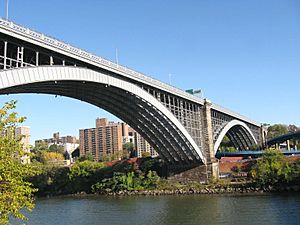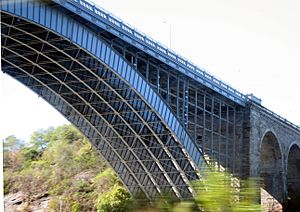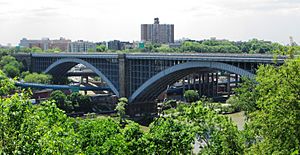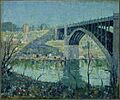Washington Bridge facts for kids
Quick facts for kids Washington Bridge |
|
|---|---|

Main arch over Harlem River; secondary arch over Metro-North Railroad and Major Deegan Expressway in the Bronx
|
|
| Coordinates | 40°50′42″N 73°55′29″W / 40.84500°N 73.92472°W |
| Carries | 6 lanes of roadway; two sidewalks |
| Crosses | Harlem River |
| Locale | Manhattan and the Bronx, New York City |
| Maintained by | New York City Department of Transportation |
| Characteristics | |
| Design | Arch bridge |
| Total length | 2,375 feet (724 m) |
| Longest span | 510 feet (160 m) |
| Clearance below | 134 feet (41 m) |
| History | |
| Opened | December 1, 1888 |
| Statistics | |
| Daily traffic | 57,647 (2016) |
The Washington Bridge is a long arch bridge in New York City. It stretches 2,375 feet (724 m) over the Harlem River. This bridge connects two important parts of New York City: Manhattan and the Bronx. It opened in 1888.
The bridge links 181st Street and Amsterdam Avenue in Washington Heights, Manhattan. On the Bronx side, it connects to University Avenue in Morris Heights, Bronx. The bridge has six lanes for cars and trucks. It also has sidewalks on both sides for people to walk. Ramps at each end connect to major highways like the Trans-Manhattan Expressway and the Cross-Bronx Expressway.
Charles C. Schneider and Wilhelm Hildenbrand designed this two-hinged arch bridge. Other engineers and companies also helped with the design. The bridge is made of steel arches and stone sections. The New York City Department of Transportation takes care of it. The Washington Bridge used to carry U.S. Route 1. Now, that route uses the Alexander Hamilton Bridge. The Washington Bridge is a special landmark in New York City. It is also listed on the National Register of Historic Places.
Plans for the Washington Bridge started in the 1860s. But it took 20 years to begin building because of disagreements. The final design was chosen in 1885, and construction began in July 1886. People could walk across it by December 1888. Cars started using it after 1906. After the George Washington Bridge opened in 1931, the Washington Bridge helped connect traffic between New Jersey and the Bronx. The Alexander Hamilton Bridge opened in 1963, taking some traffic away. The Washington Bridge was repaired and rebuilt from 1989 to 1993.
Exploring the Washington Bridge
The Washington Bridge is an arch bridge that crosses the Harlem River. It connects West 181st Street in Washington Heights, Manhattan, to University Avenue in Morris Heights, Bronx. The Harlem River flows through a valley. Manhattan is on the steeper west side, and the Bronx is on the east side. The bridge, including its ramps, is 2,375 feet (724 m) long. It has two large steel arches over the river. Stone sections, called viaducts, are at each end.
Charles C. Schneider and Wilhelm Hildenbrand were the main designers. Many other engineers and companies helped build it. The bridge used over 8,000 short tons (7,100 long tons; 7,300 t) of steel for its arches. The stone came from Maine and Connecticut.
The bridge has six lanes for traffic. There is also a sidewalk on each side. The road was first made of granite, then asphalt. The sidewalks were made of bluestone. When built, the bridge was 80 feet (24 m) wide. The road was 50 feet (15 m) wide, and sidewalks were 15 feet (4.6 m) wide. Today, the road has two 30-foot-wide (9.1 m) sections. A median strip separates them. The sidewalks are 6 feet (1.8 m) wide.
Several bus routes use the Washington Bridge. These include the Bx3, Bx11, Bx13, Bx35, Bx36 routes. In 2016, about 57,647 vehicles crossed the bridge each day. The busiest year was 2000, with 68,075 vehicles daily.
The River Spans
The bridge has two main steel arches. Each arch is 510 feet (160 m) long. The western arch crosses the Harlem River and Bridge Park. The eastern arch goes over the Metro-North Railroad's Hudson Line. It also crosses the Major Deegan Expressway. The arches are high enough for boats to pass underneath. They provide 134 feet (41 m) of space above the water.
How the Arches are Built
Each arch has six large steel beams called girders. These girders are made of strong, riveted steel. They are 13 feet (4.0 m) thick. The girders run side-by-side, 14 feet (4.3 m) apart. They are connected with diagonal and straight braces. This design made the Washington Bridge special. It was the first U.S. bridge with arch ribs made of these plate girders.
The bridge deck (the part you drive on) is supported by horizontal and vertical beams. These beams are spaced about 15 feet (4.6 m) apart. Posts extend from the arches to support these floor beams. The posts are strongly attached to the arches and beams.
The sides of the bridge deck have decorative edges called cornices. These cornices have small tooth-like shapes and decorative blocks. Below the cornice, you can see shield and branch designs. The railings have shell and seahorse patterns. They also feature egg-and-dart designs and decorative columns.
Bridge Piers
The arches rest on three main stone supports called piers. One pier is at each end of the arches. The third pier is in the middle, on the eastern bank of the Harlem River. At their base, where the arches begin, the piers are 40 feet (12 m) wide and 98 feet (30 m) long. The upper parts of the piers are made of vertical sections. They rise almost 100 feet (30 m) to the bridge deck. The inside of the piers is made of rubble or concrete. The lower parts are solid concrete, covered with cut stone.
Each pier has a solid granite railing on top. These railings surround small balconies. The balconies used to have lighted seating areas with bronze lampposts.
Bridge Approaches
The stone sections leading to the main arches are called approaches. Each approach has three large concrete arches. They are covered with granite and gneiss stone. On the Bronx side, there is a seventh, oval-shaped arch over Undercliff Avenue. All seven arches were built at the same time to make the bridge strong. Each arch has decorative stones at the top, with a central keystone. The semicircular arches are 60 feet (18 m) wide. They are supported by piers that are 13 feet (4.0 m) thick. The top of the approaches has granite railings with round openings. These railings sit on short granite ledges. When the bridge opened, the round openings had bronze flower-like decorations. The approaches also had bronze lampposts.
On the Manhattan side, there are ramps connecting to the Trans-Manhattan Expressway. This expressway carries Interstate 95 and U.S. Route 9. The approach crosses Harlem River Drive, which runs along the river. The main bridge road continues west to 181st Street and Amsterdam Avenue. This area is next to Highbridge Park. The intersection is 27 feet (8.2 m) higher than the bridge deck. This means the road goes uphill slightly. Entrances to the sidewalks are near this intersection.
The Bronx approach has three semicircular arches and one oval arch. This oval arch is 56 feet (17 m) wide. The original design included a granite staircase leading to Boscobel Place. At the eastern end, the bridge lanes split. They merge with the Cross Bronx Expressway (I-95 and US 1). Ramps connect to University Avenue. The southern sidewalk runs along Bridge Playground.
Building the Washington Bridge
Early Ideas for the Bridge
People started planning a bridge between the West Bronx and Upper Manhattan in the 1860s. The nearby High Bridge, built in the 1840s, carried water. A new bridge was proposed just north of the High Bridge. This idea came from Andrew Haswell Green in 1868. He wanted a suspension bridge higher than the High Bridge. The state approved this in 1869. The city's Parks Department was given power to plan bridges over the Harlem River. But nothing happened for several years.
In 1876, a group was chosen to get land for the bridge. They marked out a 100 feet (30 m) wide strip of land. In 1878, important people asked for a suspension bridge. They wanted to help with the growing traffic. In 1881, engineer William J. McAlpine showed four bridge designs. These included suspension bridges, a metal cantilever bridge, and a stone arch bridge. The stone arch design was suggested as the best. But again, no progress was made.
Choosing the Design
Since the Parks Department had not built the bridge in 15 years, Andrew Green asked for a new agency to take over. In June 1885, the state created the Harlem River Bridge Commission. Three commissioners were chosen in July. McAlpine became the chief engineer in September.
The commissioners decided to hold a design competition. They wanted a bridge as grand as the Brooklyn Bridge. Designs had to include a river span at least 400 feet (120 m) long. It also needed metal parts, stone piers, and an 80-foot-wide (24 m) wide deck. In December 1885, they received 17 designs. They picked four to look at more closely.
The Union Bridge Company suggested a bridge with three granite arches. But their plan did not fit the rules. The commissioners also decided against an all-stone bridge. They chose a mix of metal and stone.
In March 1886, Charles Conrad Schneider won first prize. Wilhelm Hildenbrand won second prize. Schneider's plan was too expensive, costing $3 million. The Union Bridge Company then offered a new plan. It combined ideas from Schneider and Hildenbrand. This plan used steel plate girders. The commission accepted it after some changes.
Building the Bridge

In April 1886, bids were taken for the stone and metal work. The commissioners wanted one company to do all the work. So, they rejected bids from many smaller companies. On July 14, 1886, they gave the main contract to Passaic Rolling Mill Company (for steel) and Myles Tierney (for stone). Construction began that same month. William Rich Hutton became the new chief engineer. Over 500 workers were involved in the project. During construction, the bridge was sometimes called the Manhattan Bridge.
Builders rented land on both sides of the Harlem River. This was for storing materials. On the Manhattan side, materials were brought in small amounts. A dock with cranes was built. A sloped track carried materials from the dock to the bridge site. On the Bronx side, another dock was built. Materials were first moved by wagons. Later, a platform with tracks was built.
The foundation for the western pier was ready by October 1886. The central pier's foundation was built using a special timber box called a caisson. This caisson was sunk using compressed air. Work on it began in September 1886. It reached the bedrock by May 1887. Then, stone work began. A similar caisson was used for the eastern pier.
The arches were built on temporary supports. The stone arches were framed from September 1887 to early 1888. The eastern metal arch was built and installed in January 1888. The western arch over the river was installed two months later. About 200 men worked on installing the main arches. The interior walls of the stone approaches were built from April to July 1888. By July, the deck was almost done. The road and sidewalks were laid from August to November. The bridge cost $2.85 million to build.
How the Bridge Was Used
Opening and Early Years
The Washington Bridge was mostly finished in December 1888. People with special passes could use it. In February 1889, it was named after President George Washington. This was to honor his birthday and the 100th anniversary of his presidency. The name also fit because nearby areas like Washington Heights were named after him.
The bridge was supposed to open in February, but bad weather delayed it. In March, a horse and buggy crossed without permission. By May 1889, people and vehicles were already using the bridge. The bridge never had a formal opening ceremony. This was because of disagreements between the city and the bridge commission. In December 1889, people tore down the barriers to use the bridge. By August 1890, the bridge had been in use for 18 months. But in 1891, it was still officially "unopened" due to legal issues.
In 1902, a company planned to run streetcar lines in the Bronx. One line would cross the Washington Bridge. The bridge opened to cars and streetcars in 1906. Four Bronx streetcar routes used the bridge. These routes are now bus routes (Bx13, Bx35, Bx36, and Bx3). By the 1910s, West 181st Street in Manhattan grew quickly. This was because of the streetcar lines and the opening of the New York City Subway's 181st Street subway station.
Connecting Across the City
More and more cars used the Washington Bridge over the years. By 1928, the city wanted to make the sidewalks narrower. This would create more lanes for cars. In 1929, the city asked for $300,000 to widen the bridge. This was planned with a new suspension bridge over the Hudson River to New Jersey. The contract for widening was given in November 1929. The work involved making the road 14 feet (4.3 m) wider and moving the trolley tracks.
The Hudson River bridge was named the George Washington Bridge. This caused worry about confusing the two bridges. The chairman of the Port Authority said the Harlem River bridge was often called the 181st Street Bridge. After the George Washington Bridge opened in 1931, traffic between New Jersey and the Bronx used local streets. This changed when the 178th Street Tunnel opened in 1940. The Washington Bridge became part of U.S. Route 1 in New York in 1934.
Most streetcar service on the Washington Bridge stopped in October 1947. Buses replaced them. The last streetcar route stopped in July 1948. Work to widen the Washington Bridge began in June 1949. The streetcar tracks were removed. A median barrier was built between traffic directions. This created two 30-foot-wide (9.1 m) granite roads with three lanes each. The granite sidewalks were made narrower. Work also started on the 179th Street Tunnel and the Highbridge Interchange. These projects added direct ramps from the bridge to the tunnels. The widening finished by 1950. The tunnel and interchange opened on May 5, 1952.
Changes Over Time
The Washington Bridge continued to be a busy spot for traffic. In 1955, city planner Robert Moses suggested new highways. These would help with traffic across New York City. One idea was a new bridge next to the Washington Bridge. So, the Alexander Hamilton Bridge and Trans-Manhattan Expressway were planned. They would bypass the Washington Bridge and the tunnels. These projects would connect the Bronx and New Jersey directly. They would also handle more traffic from the George Washington Bridge's new lower level. The expressway and the George Washington Bridge's lower deck opened in 1962. The Alexander Hamilton Bridge opened in April 1963. This caused traffic on the Washington Bridge to decrease. U.S. Route 1 was then moved to the Alexander Hamilton Bridge.
In 1971, the city suggested adding tolls to the Washington Bridge. They also wanted tolls on all other free bridges over the East and Harlem rivers. This would have charged drivers for entering Manhattan. But the idea failed in 1977. The United States Congress banned tolls on these bridges.
The Washington Bridge was named a New York City landmark on September 14, 1982. It was added to the National Register of Historic Places on September 22, 1983. In the 1980s, the bridge started to wear down. By 1988, the New York City Department of Transportation (NYCDOT) estimated it would cost $25 million to fix it. The deck had holes, and four of six lanes were closed. The bridge's 100th birthday was celebrated on April 29, 1989. The Washington Bridge then underwent a $33 million reconstruction. This work started in October 1989. It included replacing the deck, steel, sidewalks, and railings. Some lanes stayed open during the work. The reconstruction was finished in 1993.
Images for kids












